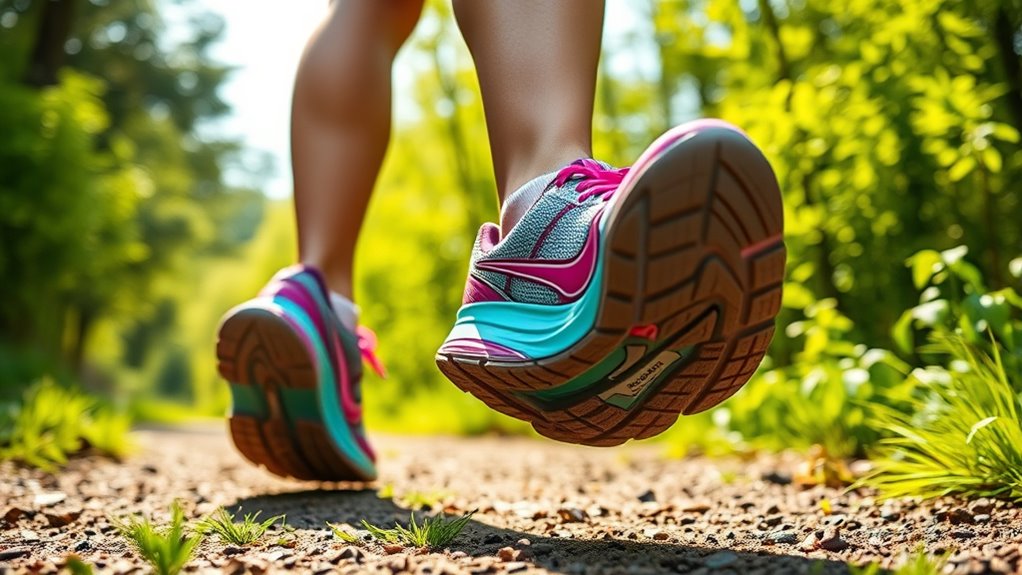If you’re looking for the best shoes to manage plantar fasciitis in 2025, I recommend options like the Brooks Adrenaline GTS 24 for support, the Ghost Max 2 for cushioning, and the Ryka Devotion X for stability. The Under Armour Charged Assert 9 and adidas Run Falcon 5 also offer great comfort and durability. Stay with me to find out why these shoes stand out and how they can help you stay active comfortably.
Key Takeaways
- Look for shoes with full-length RE-ZORB® cushioning or similar shock absorption features for effective plantar fasciitis relief.
- Prioritize models with wide toe boxes and supportive heel counters to accommodate bunions and reduce strain.
- Choose shoes designed for long-lasting support, durability, and impact resistance on various surfaces.
- Select lightweight, breathable options to enhance comfort during extended walking or running sessions.
- Ensure the shoes offer ergonomic design elements that promote natural gait and reduce pressure on the plantar fascia.
Brooks Women’s Adrenaline GTS 24 Supportive Running Shoe
If you’re looking for a running shoe that offers exceptional support and comfort for women with plantar fasciitis, the Brooks Women’s Adrenaline GTS 24 stands out. I’ve found these shoes to be true to size, with a snug yet supportive fit that feels lightweight and breathable. The wide toe box and plush cushioning, especially around the heel, provide stability and reduce joint impact. Many users, including myself, notice immediate relief from foot pain and improved support during long walks or runs. They’re stylish, easy to clean, and durable enough for regular indoor or treadmill use, making them a reliable choice for daily comfort.
Best For: women seeking supportive, comfortable running shoes that alleviate foot pain from conditions like plantar fasciitis and bunions.
Pros:
- Excellent support and cushioning, especially around the heel and arch
- True to size with a wide toe box for comfort and bunion accommodation
- Lightweight, breathable, and stylish, suitable for long walks, runs, and daily wear
Cons:
- Slightly expensive compared to other brands or models
- Sole durability may be compromised on hard outdoor surfaces over time
- Some users may need half a size larger for a perfect fit to avoid toe rubbing
Brooks Women’s Ghost Max 2 Neutral Running & Walking Shoe
The Brooks Women’s Ghost Max 2 is an excellent choice for women with plantar fasciitis who need a supportive, cushioned shoe that can handle daily activities. It offers exceptional comfort with plush padding and shock absorption, reducing joint soreness and foot fatigue. The wide toe box comfortably fits bunions and foot issues, and the breathable upper keeps feet cool. Although initially a bit heavy, the shoe becomes more comfortable over time. Durable and stylish, it’s perfect for running, walking, or long shifts. Stability and grip are excellent on various surfaces, making it a versatile, reliable option for those seeking support and comfort.
Best For: women seeking a supportive, cushioned shoe for daily activities, long shifts, or managing foot conditions like plantar fasciitis.
Pros:
- Exceptional cushioning and shock absorption reduce joint and foot soreness
- Wide toe box comfortably accommodates bunions and foot issues
- Durable, stylish, and suitable for various activities including walking and running
Cons:
- Can feel heavy initially, though comfort improves with use
- May cause feet to slide outward on uneven terrain or thick grass
- Not ideal for activities requiring lateral stability or with foot braces
Under Armour Womens Charged Assert 9 Running Shoe
Designed with lightweight support and responsive cushioning, the Under Armour Women’s Charged Assert 9 Running Shoe is an excellent choice for women with plantar fasciitis seeking comfort and stability during runs. Its engineered mesh upper is breathable and strategically supports key areas, reducing strain. The foam padding around the ankle collar and under the tongue guarantees a comfortable fit, while the comfort sockliner molds to your foot with heel padding for added cushioning. The Charged Cushioning® midsole offers responsiveness and durability, perfect for absorbing impact. The tire-inspired outsole provides flexibility and superior traction, making this shoe a reliable option for those needing both support and comfort on every run.
Best For: women seeking lightweight support, responsive cushioning, and stability during runs, especially those with plantar fasciitis.
Pros:
- Engineered mesh upper provides breathability and strategic support
- Foam padding and heel cushioning enhance comfort and fit
- Charged Cushioning® midsole delivers responsiveness and durability
Cons:
- May feel less supportive for overpronators without additional stability features
- Slightly heavier than minimalist running shoes
- The tread pattern might wear faster with extensive use on rough surfaces
Brooks Women’s Revel 7 Neutral Running Shoe
For women with plantar fasciitis seeking a reliable daily shoe, the Brooks Women’s Revel 7 Neutral Running Shoe stands out thanks to its exceptional cushioning and arch support. Many users praise how comfortable and supportive they feel, making them perfect for walking and casual wear. They fit true to size, though some recommend sizing up half a size for wider feet. Lightweight and supportive, they have a roomy toe box that balances softness with stability. Users report relief from knee pain and foot issues, appreciating the shoe’s durability and good traction. Stylish and affordable, the Revel 7 is a versatile choice for everyday comfort and support.
Best For: women seeking comfortable, supportive, and stylish shoes for walking, casual wear, or light running, especially those with plantar fasciitis or foot issues.
Pros:
- Excellent cushioning and arch support provide all-day comfort and relief from foot pain
- True to size fit with a supportive, roomy toe box suitable for wider feet
- Durable with reliable traction, ideal for daily walking and casual activities
Cons:
- Some users may prefer to size up half a size for a better fit, especially for wider feet
- Limited color options in certain sizes, which may affect style choices
- Primarily designed for walking and casual use, not suitable for intense running or athletic activities
adidas Womens Run Falcon 5 Sneakers
If you’re looking for an affordable, supportive sneaker for everyday wear, adidas Womens Run Falcon 5 Sneakers can be a great choice. They feature lightweight Cloudfoam cushioning and Ortholite insoles that enhance comfort, especially for tired or older feet. These shoes support arches well and are praised for their comfort during long hours on your feet, like work shifts. They fit true to size and generally don’t cause discomfort during extended wear. While they’re ideal for walking, light jogging, and casual activities, some users find they lack enough support for serious running, especially if you have flat feet. Overall, they’re stylish, versatile, and budget-friendly.
Best For: those seeking an affordable, comfortable, and stylish sneaker for everyday activities like walking, errands, and casual outings.
Pros:
- Lightweight Cloudfoam cushioning provides all-day comfort and support
- Ortholite insoles help reduce fatigue and support arches, ideal for long hours on feet
- Versatile and stylish design that pairs well with various casual outfits
Cons:
- May lack sufficient support for serious or long-distance running, especially for flat-footed individuals
- Durability can decline after a few months of regular use, with some parts wearing or coming unglued
- Not suitable for high-impact sports or intense workouts requiring advanced support
Ryka Womens Devotion X Walking Shoe
The Ryka Womens Devotion X Walking Shoe stands out as an excellent choice for women with plantar fasciitis who need reliable support and cushioning during their walks. Awarded the American Podiatric Medical Association Seal of Acceptance, it promotes good foot health. The shoe features full-length RE-ZORB® responsive cushioning for shock absorption, along with additional support in the forefoot and heel. Its durable rubber outsole offers grip and impact protection, while ACTIVfoam™ EVA provides soft comfort. Constructed with breathable mesh uppers and padded heel, it ensures comfort and sustainability. The secure lace-up closure and built-up midfoot deliver a customized fit and stability, making it a dependable walking companion.
Best For: women seeking a supportive, cushioned walking shoe that promotes foot health and comfort, especially those with plantar fasciitis.
Pros:
- Awarded the American Podiatric Medical Association Seal of Acceptance, ensuring foot health benefits
- Full-length RE-ZORB® cushioning provides excellent shock absorption and impact protection
- Breathable mesh uppers and padded heel enhance comfort and sustainability
Cons:
- Weight of 8.7 oz per shoe may feel slightly heavier for some users
- Designed specifically for walking, limiting versatility for other activities
- May require proper fit adjustments due to lace-up closure for optimal support
Brooks Women’s Ghost 17 Neutral Running Shoe
Looking for a running shoe that offers unmatched comfort and support for women with plantar fasciitis? The Brooks Women’s Ghost 17 is a standout choice. It provides exceptional cushioning that absorbs impact and prevents foot fatigue, with a true-to-size fit and ample toe box room. Many users say they feel like slippers, perfect for long walks, standing, or extended shifts. Available in extra-wide options, it comfortably accommodates wider feet and issues like bunions or hammertoes. The lightweight, breathable design keeps feet cool, while the supportive structure ensures stability. Overall, the Ghost 17 combines style, comfort, and durability, making it an excellent option for extended wear.
Best For: women seeking a highly comfortable, supportive, and stylish running shoe suitable for long walks, standing, and those with foot conditions like plantar fasciitis, bunions, or hammertoes.
Pros:
- Exceptional cushioning that absorbs impact and reduces foot fatigue
- True-to-size fit with ample toe box room, accommodating wider feet and foot issues
- Lightweight, breathable design with stylish color options suitable for various activities
Cons:
- Some users report the padding may flatten over time with extended use
- Initial tightness of laces can cause ankle discomfort if not adjusted properly
- Slight difficulty in discerning color shades in stores for certain designs
Factors to Consider When Choosing Plantar Fasciitis Running Shoes Women

When choosing running shoes for plantar fasciitis, I consider several key factors to make certain of comfort and support. I look at the quality of arch support, the right level of cushioning, and if the fit is secure enough to prevent slipping. Additionally, I pay attention to traction, stability, and breathability to keep my feet comfortable during every run.
Arch Support Quality
Choosing running shoes with high-quality arch support is essential for women with plantar fasciitis because it helps distribute pressure evenly across the foot and reduces strain on the plantar fascia. Shoes with reinforced medial arch areas offer better stabilization, which can alleviate pain and prevent overpronation—an issue often linked to inflammation. The level of support needed varies depending on your arch type; flatter arches typically require more substantial support. Proper arch support also promotes better foot alignment, decreasing the risk of aggravating symptoms. Investing in shoes with reliable arch support ensures your foot stays properly aligned during runs, minimizing discomfort and preventing further injury. Ultimately, well-designed arch support is a key element in managing plantar fasciitis effectively.
Cushioning Level Needed
Since proper arch support helps align your foot, the cushioning level also plays a crucial role in managing plantar fasciitis. Shoes with high levels of cushioning help absorb impact and reduce pressure on the plantar fascia, easing pain during activity. Adequate cushioning provides essential shock absorption that minimizes stress on your heel and arch, which is essential for relief. However, too soft cushioning might compromise stability, so finding a balance between support and softness is key. For women with plantar fasciitis, moderate to high cushioning levels are generally recommended to prevent aggravating the condition during running or walking. The right cushioning can also help prevent further injury by reducing strain on overworked foot tissues during extended periods of activity, ensuring comfort and protection.
Proper Shoe Fit
A proper shoe fit is essential for managing plantar fasciitis because it directly affects how comfortably and effectively your shoes support your feet. When shoes fit well, they comfortably accommodate the width and length of your feet, reducing pressure on the plantar fascia. Shoes that are too tight can cause additional pain and worsen symptoms, while those too loose may lead to instability and improper gait. Look for a snug heel counter to prevent slipping and a wide toe box to avoid cramping and allow natural toe movement. Ensuring the shoes are true to size or slightly roomier, especially in length and width, is key for comfort. Proper fit helps distribute body weight evenly across your foot, decreasing strain and supporting your recovery.
Traction and Stability
When selecting running shoes for plantar fasciitis, paying attention to traction and stability can make a big difference in comfort and safety. Good traction helps prevent slips and falls, especially on uneven surfaces or during quick movements. Shoes with textured outsoles, like herringbone or tire-inspired patterns, provide better grip and durability for daily wear. Stability features, such as wide bases, firm midsoles, reinforced heel counters, and supportive arches, reduce excessive foot roll and improve balance. These elements help maintain proper gait alignment, which is essential for reducing strain on the plantar fascia and preventing further discomfort. When your shoes offer reliable traction and stability, you’ll feel more confident during your runs and enjoy a safer, more comfortable experience overall.
Breathability Features
Breathability is a crucial feature to take into account when choosing running shoes for plantar fasciitis, as it directly impacts foot comfort and health. Shoes with mesh or perforated uppers allow air to circulate, keeping feet cool and dry during activity. Good airflow helps reduce sweat buildup, which minimizes blisters, odors, and fungal infections that can worsen foot problems. Moisture-wicking linings and ventilation features maintain an ideal foot temperature, preventing overheating and discomfort during long runs. Proper breathability also promotes overall foot health by reducing moisture that can cause skin irritation and fungal issues. Lightweight, breathable materials contribute to a less restrictive fit, making shoes more comfortable and helping to reduce fatigue during extended wear.
Heel and Sole Design
Choosing the right heel and sole design is essential for managing plantar fasciitis during runs, as it directly influences shock absorption and foot stability. A supportive heel counter combined with a cushioned midsole helps absorb shock at heel strike, reducing strain on the plantar fascia. A thick, shock-absorbing outsole made from durable materials minimizes impact and offers stability across different surfaces. An ergonomic, slightly beveled heel encourages proper gait alignment and decreases excessive heel movement that can irritate plantar fasciitis. A wide, stable heel base improves balance and prevents inward rolling, which often worsens symptoms. Additionally, proper heel height and sole contour support natural foot biomechanics, distributing pressure evenly and alleviating discomfort. These design elements work together to provide the support needed for comfortable, pain-free running.
Durability for Daily Use
Durability plays a key role in ensuring that your running shoes for plantar fasciitis hold up through daily use. High-quality outsoles made of rubber or reinforced foam are essential, as they can withstand frequent contact with different surfaces without wearing down quickly. The shoe’s upper materials should resist tears and maintain support despite daily wear, keeping the shoe’s structure intact. Reinforced stitching and sturdy construction further extend the shoe’s lifespan by preventing early breakdown in key support areas. Shoes designed for everyday use should strike a balance between cushioning and support while maintaining a solid build to avoid premature sole compression or material degradation. Regularly inspecting the outsole and midsole helps catch wear signs early, ensuring ongoing durability and effective plantar fasciitis management.
Suitable Activity Types
Have you ever wondered how to pick running shoes that truly support your activities and alleviate plantar fasciitis pain? The key is choosing footwear designed for your specific activity. For running, look for shoes with excellent shock absorption and cushioning to reduce impact on your plantar fascia. If walking is your main activity, opt for shoes with enhanced support and stability to control foot motion and prevent overpronation or supination. A wide toe box is essential to accommodate swelling and prevent pressure on sensitive areas. Prioritize shoes with firm yet flexible arch support to maintain proper alignment across different movements. Matching your shoes to your activity ensures ideal comfort, minimizes strain, and helps you stay active without aggravating plantar fasciitis.
Frequently Asked Questions
How Often Should I Replace My Running Shoes for Plantar Fasciitis?
You should replace your running shoes every 300 to 500 miles or every 6 to 8 months, whichever comes first. I keep an eye on the sole wear and cushioning; if I notice less support or visible damage, it’s time for new shoes. Regularly updating your shoes helps prevent aggravating plantar fasciitis and keeps your feet comfortable and supported during runs.
Can Insoles Improve Support in My Existing Running Shoes?
Yes, insoles can definitely improve support in your existing running shoes. I’ve found that adding cushioned or orthotic insoles helps stabilize my feet and reduces heel pain from plantar fasciitis. Make sure to choose insoles designed for arch support and shock absorption. They’re an affordable way to customize your shoes, offering extra comfort and support without needing to buy new ones. Give it a try—you might notice a big difference!
Are There Specific Shoe Features That Help Reduce Plantar Fasciitis Pain?
Yes, certain shoe features can really help reduce plantar fasciitis pain. I look for shoes with good arch support, a firm heel counter, and cushioning in the midsole. A slight heel lift can also relieve tension on my plantar fascia. I avoid shoes with flat soles or minimal support. These features keep my foot aligned and absorb shock, easing pain during my runs and daily activities.
How Does Running Surface Impact Plantar Fasciitis Symptoms?
Running surface really impacts my plantar fasciitis symptoms. I’ve found that softer surfaces like grass or trails reduce impact and give my feet more cushioning, easing pain. Hard surfaces like concrete or asphalt increase strain, making symptoms worse. So, I always choose gentler terrains when I run. Switching to softer surfaces has genuinely helped me manage discomfort, and I recommend it to anyone dealing with plantar fasciitis.
Is It Necessary to Consult a Specialist Before Choosing Running Shoes?
Yes, I believe consulting a specialist is important before choosing running shoes, especially if you have plantar fasciitis. They can assess your specific needs, identify underlying issues, and recommend the best footwear to prevent worsening symptoms. I’ve found that expert advice helps me avoid unnecessary pain and guarantees I pick shoes with the right arch support and cushioning, making my runs more comfortable and safe.
Conclusion
Choosing the right running shoes for plantar fasciitis is about comfort, support, and fit. It’s about reducing pain, enhancing performance, and enjoying every stride. It’s about finding shoes that cushion, support, and stabilize. Because when your shoes fit well, when your shoes support you, when your shoes feel right — you’ll be able to run, walk, and move with confidence, comfort, and care. So prioritize your needs, and step forward with every stride.

















